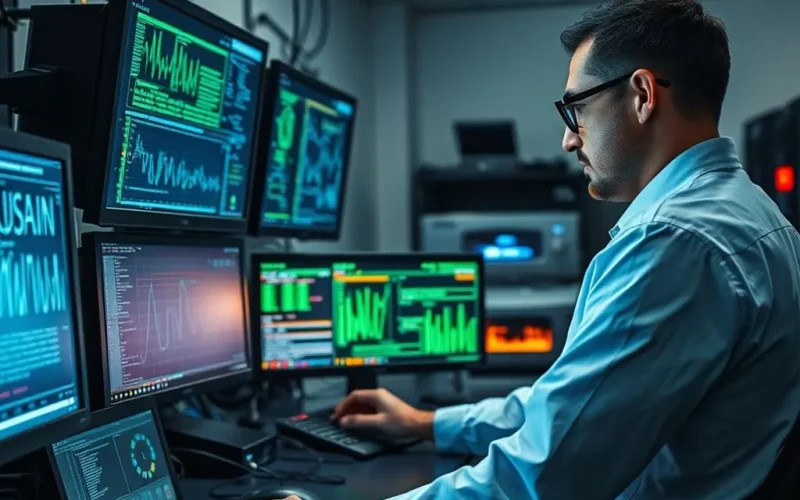Ever found yourself glued to a crime show, watching detectives meticulously piece together clues to solve a complex case? Imagine that same level of intricate investigation, but instead of fingerprints and DNA samples, the clues are digital bytes, hidden in the deepest corners of computers, smartphones, and cloud servers. Welcome to the captivating world of Digital Forensics – it’s essentially CSI, but for the digital realm!
Just like a seasoned detective, a digital forensics expert embarks on a systematic journey. Their mission? To investigate and recover data from electronic devices, uncovering compelling evidence that can shed light on cybercrimes, intellectual property theft, corporate espionage, or even simply help recover accidentally lost information. They dig deep, sifting through hard drives, solid-state drives, external storage, mobile phones, and cloud accounts, meticulously searching for digital footprints: deleted messages, browser histories, file timestamps, and metadata. Every byte is analyzed, every fragment of data scrutinized to reconstruct events and unveil the truth.
Because, in the vast, ever-expanding digital world, the data never truly dies. It might be deleted, encrypted, or hidden, but with the right tools and expertise, it can often be brought back to life.
Before we dive deeper into the fascinating process, why not take a quick byte-sized look? Our recent YouTube Shorts video offers a snappy overview:
Table of Contents
Understanding the Core of Digital Forensics
At its heart, digital forensics is a specialized branch of forensic science that focuses on the recovery and investigation of material found in digital devices, often in relation to computer crime. The primary goal is to identify, preserve, recover, analyze, and present facts about digital information in a legally admissible manner. This means that not only must the evidence be found, but it must be handled in such a way that its integrity is maintained, ensuring it can stand up in a court of law.
Think of it as collecting evidence from a crime scene. Just as a physical crime scene must be secured to prevent contamination, a digital crime scene (the device or network) must be handled with extreme care to prevent alteration or destruction of potential evidence. Any misstep can render crucial data useless or inadmissible.

The Digital Forensic Process: A Step-by-Step Approach
While specific methodologies can vary, most digital forensic investigations adhere to a structured process to ensure thoroughness and legal compliance. This process is crucial for maintaining the chain of custody and the integrity of the evidence.
1. Identification
This initial phase involves recognizing potential sources of digital evidence. Where might the relevant information reside? This could be anything from laptops, desktops, servers, and external hard drives to smartphones, tablets, USB drives, cloud storage, and network devices. Investigators also identify the type of incident (e.g., malware attack, data breach, internal fraud) to determine the scope of the investigation.
2. Preservation
Once identified, the digital evidence must be meticulously preserved without alteration. This is arguably the most critical step. Forensic experts create exact, bit-for-bit copies (forensic images) of storage media using specialized hardware and software write-blockers to prevent any changes to the original evidence. Hashing algorithms (like MD5 or SHA-256) are used to generate a unique digital fingerprint of the original data and its copy, proving that no changes occurred during the imaging process.
3. Collection
This stage involves securely acquiring the preserved data. Depending on the scenario, this might include seizing physical devices, remotely acquiring data from networks, or extracting information from cloud services. Proper documentation of the collection process, including timestamps and photographs, is paramount.
4. Examination
With the forensic images in hand (the copies, never the originals!), examiners use specialized forensic software tools to analyze the raw data. This goes beyond what a typical operating system can see. They look for deleted files, hidden partitions, registry entries, system logs, internet history, email communications, chat logs, and much more. The goal is to extract all potentially relevant data.
5. Analysis
The extracted data is then meticulously analyzed to reconstruct events, identify patterns, and draw conclusions. This is where the digital detective’s critical thinking comes into play. They correlate information from various sources, analyze timelines, identify user activities, and trace the flow of data to build a comprehensive picture of what transpired. For instance, analyzing log files can reveal when a specific file was accessed, or recovering deleted emails can expose communication related to a fraudulent scheme.
6. Reporting
Finally, the findings are compiled into a clear, concise, and comprehensive report. This report details the methodologies used, the evidence found, and the conclusions drawn. It must be understandable to non-technical individuals (like lawyers or jury members) and include an expert opinion, all while being legally sound and defensible in court.

Why is Digital Forensics Indispensable Today?
In our increasingly digital world, the need for digital forensics has skyrocketed. It plays a crucial role in:
- Cybercrime Investigations: From hacking and ransomware attacks to online fraud and identity theft, digital forensics helps law enforcement track down perpetrators and gather evidence for prosecution.
- Corporate Investigations: Companies rely on digital forensics to investigate insider threats, intellectual property theft, data breaches, policy violations, and employee misconduct.
- Data Recovery: Beyond criminal investigations, forensics techniques can be used to recover accidentally deleted files, restore data from corrupted drives, or salvage information from damaged systems.
- Litigation Support: In civil cases, digital evidence can prove or disprove claims related to contracts, employment disputes, or intellectual property rights.
- Incident Response: After a cybersecurity incident, digital forensics helps organizations understand how the breach occurred, what data was compromised, and how to prevent future attacks.
Different Flavors of Digital Forensics
Just as there are different types of crimes, there are different specializations within digital forensics:
- Computer Forensics: The original and broadest category, focusing on desktop and laptop computers, servers, and storage media. It examines file systems, operating system artifacts, user activity, and application data.
- Mobile Forensics: Specializes in extracting and analyzing data from mobile devices like smartphones and tablets. This includes call logs, SMS messages, GPS locations, app data, and social media interactions.
- Network Forensics: Involves monitoring and analyzing network traffic to identify security incidents, malware propagation, unauthorized access, or data exfiltration. It’s like watching the digital highways for suspicious activity.
- Cloud Forensics: Deals with acquiring and analyzing data stored in cloud environments (e.g., AWS, Azure, Google Cloud). This presents unique challenges due to shared infrastructure and complex data models.
- Database Forensics: Focuses on analyzing database systems to recover and examine evidence related to data manipulation, unauthorized access, or data breaches within databases.

The Challenges Digital Forensics Experts Face
While incredibly powerful, digital forensics is not without its hurdles:
- Volume of Data: Modern storage devices hold terabytes of information, making the analysis process time-consuming and resource-intensive.
- Encryption: Strong encryption, while vital for privacy and security, can be a major roadblock for forensic examiners trying to access data.
- Anti-Forensics Techniques: Perpetrators often employ methods like data wiping, steganography (hiding data within other files), or using live CDs/USB drives to avoid leaving traces.
- Cloud Complexity: Data spread across multiple cloud providers and jurisdictions makes traditional forensic acquisition challenging. Legal frameworks and data residency laws add further layers of complexity.
- Legal and Ethical Considerations: Ensuring proper legal warrants, maintaining chain of custody, and respecting privacy rights are constant considerations.
Who Are These Digital Detectives?
Digital forensics professionals come from diverse backgrounds and work in various sectors:
- Law Enforcement: Police departments, FBI, and other governmental agencies employ forensic examiners to investigate cybercrimes and gather evidence for criminal prosecutions.
- Private Consulting Firms: Many specialized firms offer digital forensics services to corporations, law firms, and individuals for civil cases, corporate investigations, and data recovery.
- Corporate Security Teams: Large organizations often have in-house digital forensics capabilities as part of their incident response and cybersecurity teams.
- Cybersecurity Firms: Companies specializing in cybersecurity often integrate forensic analysis into their broader service offerings to help clients recover from breaches.
Frequently Asked Questions About Digital Forensics
Q1: Can deleted files truly be recovered?
A: Often, yes! When you ‘delete’ a file, the operating system usually just marks the space it occupied as available for new data, but the actual data remains until it’s overwritten. Digital forensic tools can recover these files if new data hasn’t already taken their place.
Q2: How long does a digital forensic investigation take?
A: The duration varies greatly depending on the complexity of the case, the volume of data, the number of devices involved, and the specific questions being asked. It can range from a few days for a straightforward data recovery to several months for a complex cybercrime investigation.
Q3: Is digital forensics only for criminal cases?
A: Absolutely not. While it’s critical in criminal investigations, digital forensics is widely used in civil litigation, corporate investigations (e.g., employee misconduct, intellectual property theft), data recovery, and incident response for cybersecurity breaches.
Q4: What skills are needed to become a digital forensics expert?
A: A strong foundation in computer science, networking, and operating systems is essential. Additionally, critical thinking, problem-solving skills, meticulous attention to detail, a solid understanding of legal procedures, and continuous learning are vital.
Q5: Is it ethical to recover data from someone’s device without their consent?
A: This is a critical legal and ethical consideration. In most jurisdictions, recovering data from a device without the owner’s explicit consent or a valid legal warrant (like a search warrant) is illegal. Digital forensic experts must always operate within legal and ethical boundaries.
The Unseen World of Digital Clues
Digital forensics is a fascinating field, constantly evolving to keep pace with new technologies and sophisticated cyber threats. It’s the essential bridge between the visible digital world and the hidden traces beneath, providing clarity and accountability in an increasingly complex environment. Whether in the courtroom or the boardroom, the work of digital forensic experts ensures that in the digital realm, the truth can always be uncovered. It’s truly about bringing justice to the bytes.





